 |
|
 |
The foundations of the Lyon method of physiotherapy of vertebral deviations were described 200 years ago by Charles Gabriel Pravaz. This is the oldest of the methods worldwide, and the first combining exercises and mechanical correction of scoliosis.
|
 |
|
 |
Long before Pravaz, in the Middle Ages, Ambroise Paré used an iron brace, derived from the armor of the time, which remained in use for several centuries. Likewise gymnastic exercises are very old.
|
 |
In the seventeenth century, Francis Glisson notes the frequency of infantile scoliosis in children rickets.
|
 |
Nicolas Andry was born in Lyon. In 1741 he published an "Introduction to Orthopedics". The term is created from 2 Greek roots Child and Right. It specifies different methods to prevent and correct spinal deformities in children.
|
 |
The torso tree from Nicolas Andry's book is a symbol used by many orthopaedic societies around the world.
|
 |
The lyon method is the oldest PSSE which consists of individually adapted and curve -specific exercises.
|
 |
This is undoubtedly the reason why the Lyon method is the first to combine specific exercises and orthopaedic devices such as the brace. This complementarity still persists today.
|
 |
Since the creation of the concept of orthopedics, progress in treatment will progress rapidly. The use of plaster marks a step, because it will greatly improve the creep or plastic deformation of the concavity.
|
 |
The XIXth century is that of the first orthopedic reeducation centers in Europe and at the same time braces will develop.
|
 |
Charles Gabriel Pravaz, the creator of the Lyon method was not only a doctor, but also an engineer, a pupil of the prestigious polytechnic school of Paris. This explains why he was the inventor of the syringe and why he developed ingenious methods of correcting scoliosis.
|
 |
|
  |
Here is the Orthopedic and Pneumatic Institute located in Lyon and managed by Charles Gabriel Pravaz, then by his son until the end of the 19th century.
|
 |
The first Lyon brace in leather and steel was created by Stagnara 70 years ago. It undergoes a first change with the replacement of leather by polymethacrylate. In 2013, the use of very high rigidity polyamide and asymmetry allowed to avoid the plaster cast which was the characteristic of the Lyon Brace.
|
 |
The exercises used at that time were already based on self-elongation with a helical ladder system for working spiral chains
|
 |
Translation along the vertical axis is usually performed at night on a special bed with progressive extension. Subsequently a wheel system will allow the child to move during the day while maintaining traction to obtain a plastic deformation.
|
 |
Vertebral traction systems prefiguring the frames of Risser, Abbott and Cotrel-EDF (Elongation, Derotation, Flexion) to obtain plastic deformation were already used.
|
 |
Corrections in the frontal plane are also used. In this corrective bending position for a thoraco-lumbar curvature, the lumbar lordosis is preserved.
|
 |
Later, White and Panjabi calculated the relative corrective moment of axial translation and bending in the frontal plane as a function of angulation. At this time the angulations were important, and the axial traction privileged. Therefore, the Lyon method is adapted to a scoliosis of more than 40 °.
|
 |
The sporting activity supplements the specific exercises. Balneotherapy was also widely used. You notice the kyphotic exercises of climbing rope. The daily repetition of these exercises allows a progressive strengthening of the extra-pyramidal deep automatic musculature.
|
 |
The engravings of Pravaz's books are very explicit. The postures taken by Schroth were already practiced in Lyon, and throughout Europe, 200 years ago...
|
 |
Before Sherrington's work on the cat, at the time of Pravaz's book, the search for a sense of balance was in full progress. The French physician and biologist Jean Pierre Flourens describes the vestibular apparatus as a fundamental element of balance.
|
 |
The anatomo-physiological bases of the extrapyramidal system will complete this session.
|
 |
Here Claude Bernard is surrounded by students, colleagues and research assistants. He is the creator of Experimental Medicine as opposed to empirical and observational medicine, Science is a permanent exchange between theory and experimental facts. “For a man of science, there is no separate science of medicine or physiology, there is only a science of life.” 1865
|
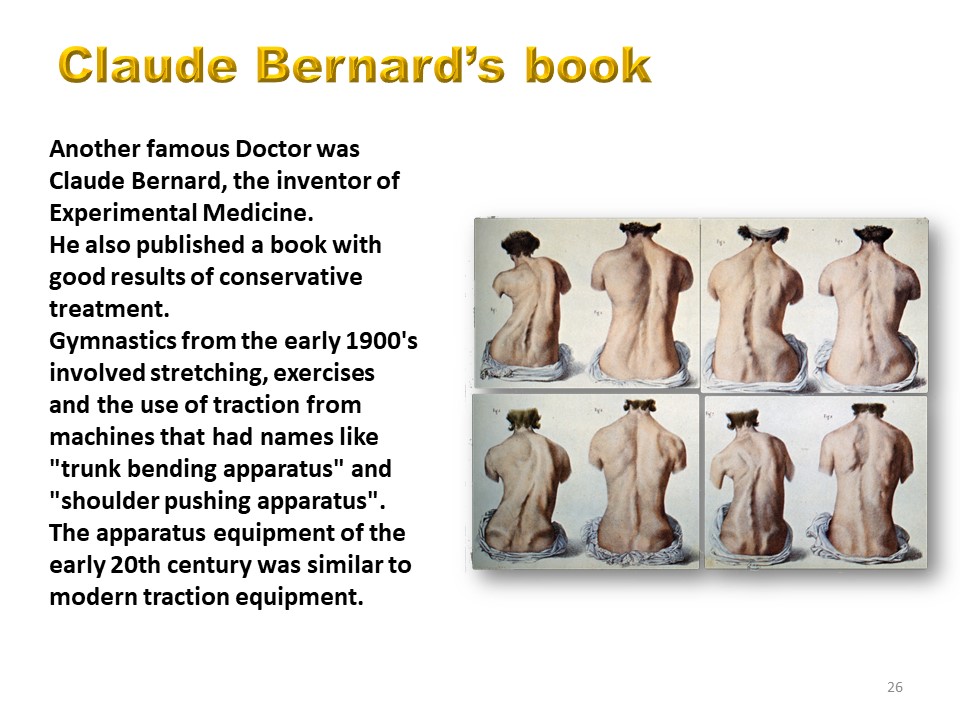 |
He also published a book with good results of conservative treatment.
|
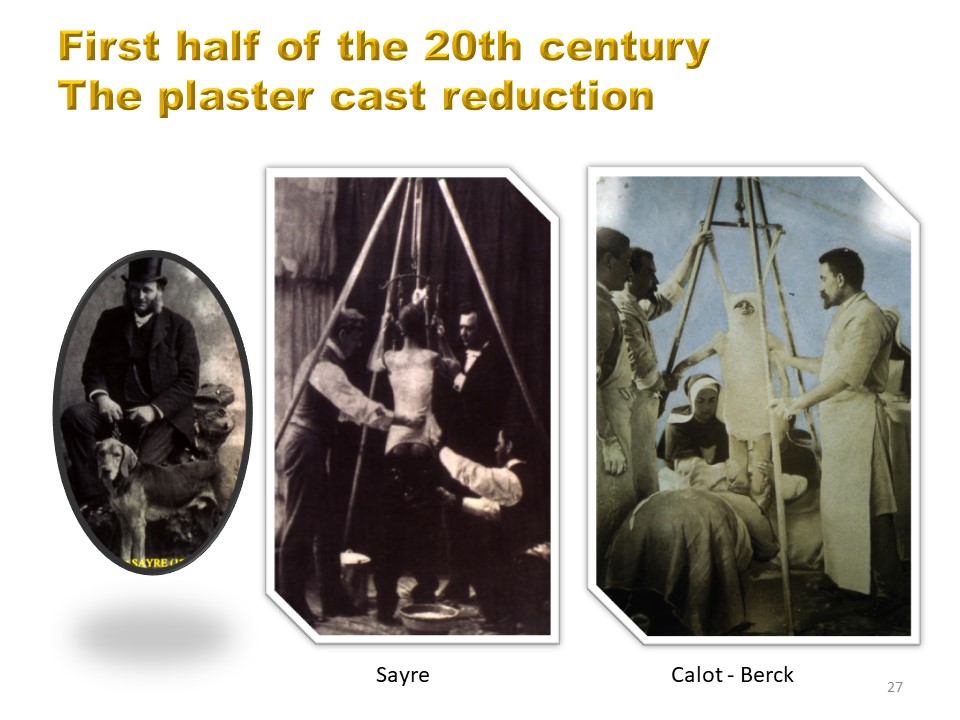 |
The plaster cast dates from the beginning of the XXth century and comes from the United States. Calot at Berck will use Sayre's correction principles. The plaster cast is made in a standing position, the elongation effect has priority.
|
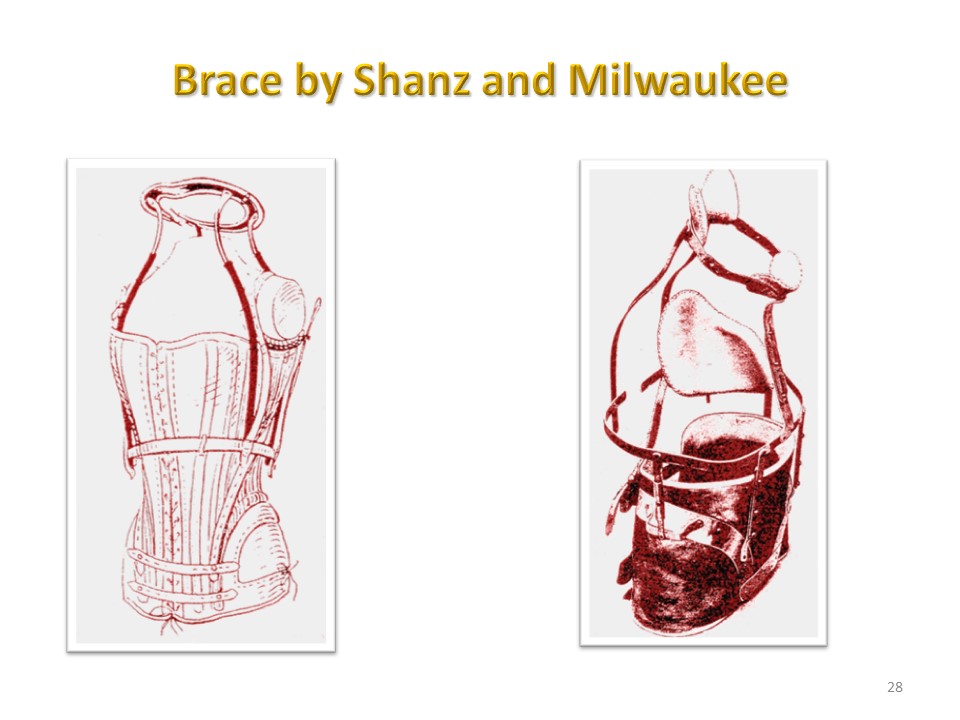 |
The braces are improved. Here the Shantz brace is very close to the Milwaukee of Blount and Schmidt.
|
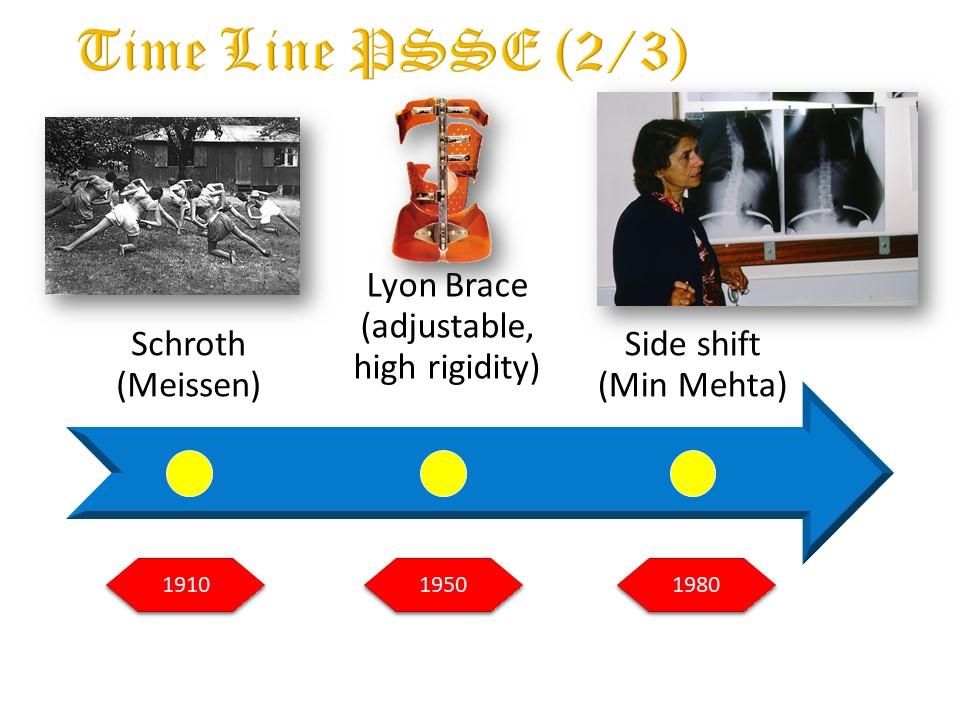 |
Schroth's method was also born at the start of the 20th century. The Lyon brace dates from the last world war, it is the only adjustable underarm brace. More recently Min Mehta uses translation along the transverse axis of the vertebrae as a basic exercise for lumbar and thoraco-lumbar curvatures.
|
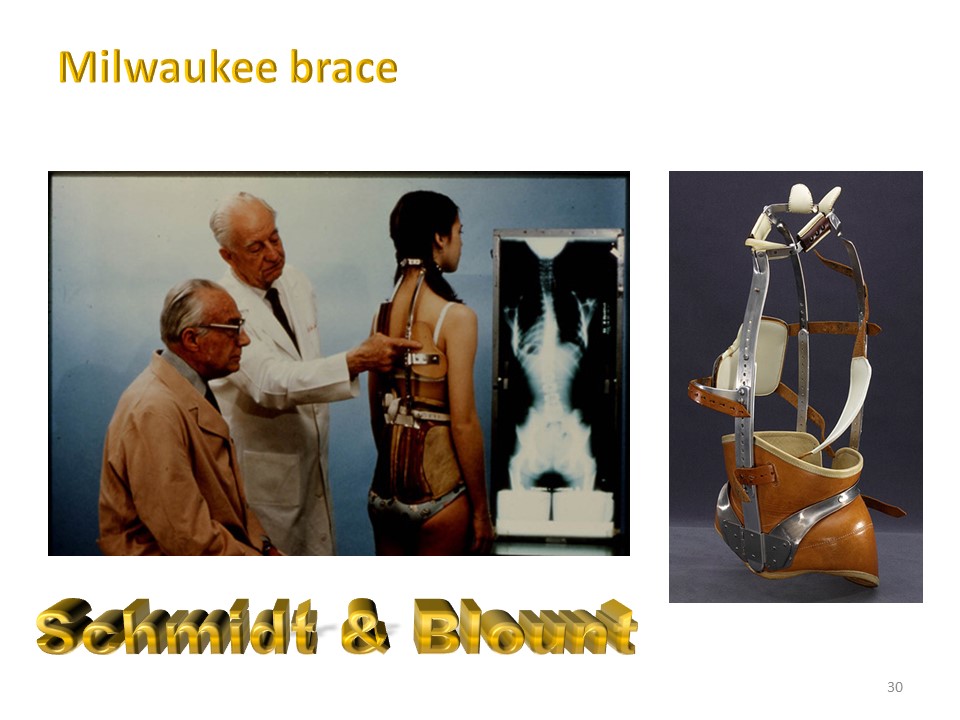 |
Schmidt and Blount, the creators of the Milwaukee brace, adapt the brace to the child. Note the pelvic retroversion characteristic of braces at this time.
|
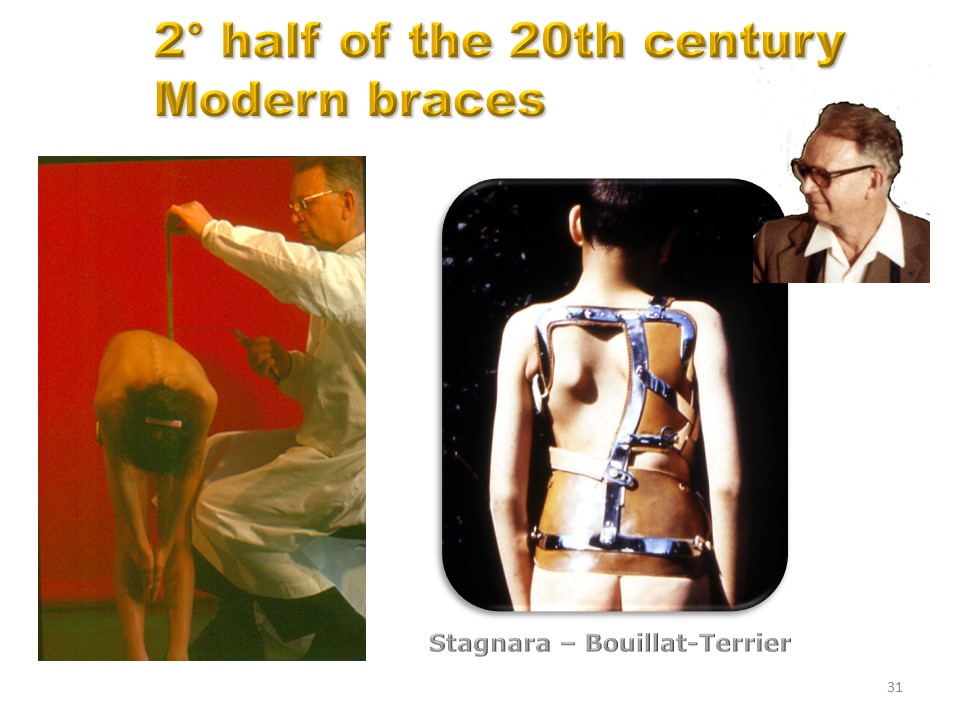 |
Here Pierre Stagnara the creator of the Lyon brace, measuring the rib hump using a plumb line. The brace is always adjustable before the end of growth.
|
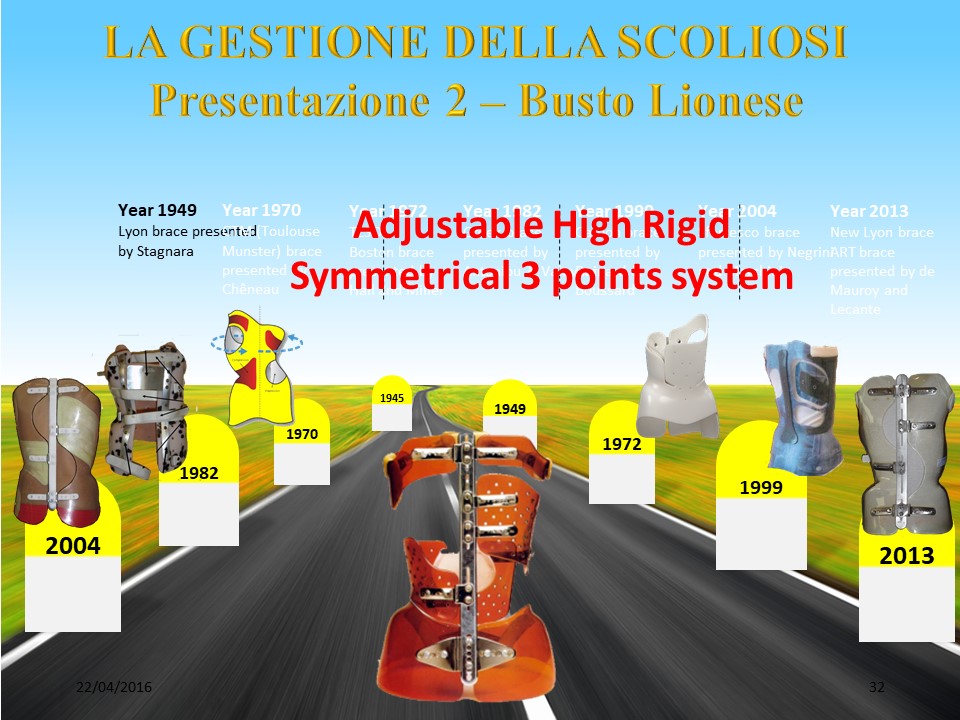 |
Subsequently, many braces will be used. They often take the name of their authors or city of origin. They have in common the fact of being made on molding without correction.
|
 |
The Lyon brace continues to be made after a corrective plaster cast and is always adjustable during the growth period.
|
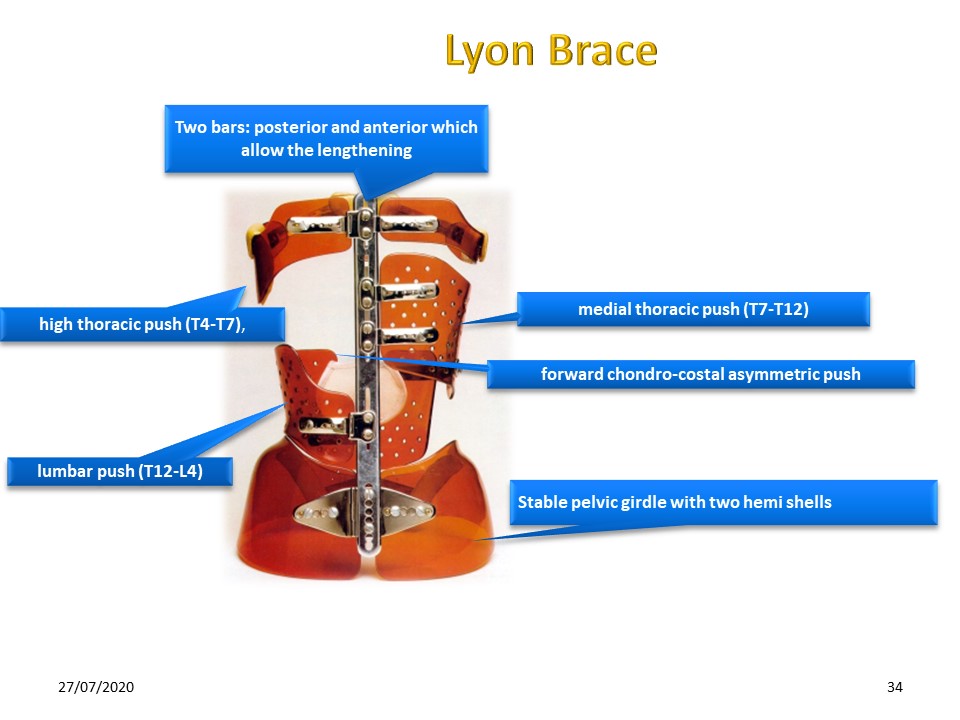 |
The Lyon brace of Stagnara has anterior and posterior masts on which are articulated support valves at the level of the convexities and expansions at the level of the convexities. Both shoulder and pelvic girdles are stable.
|
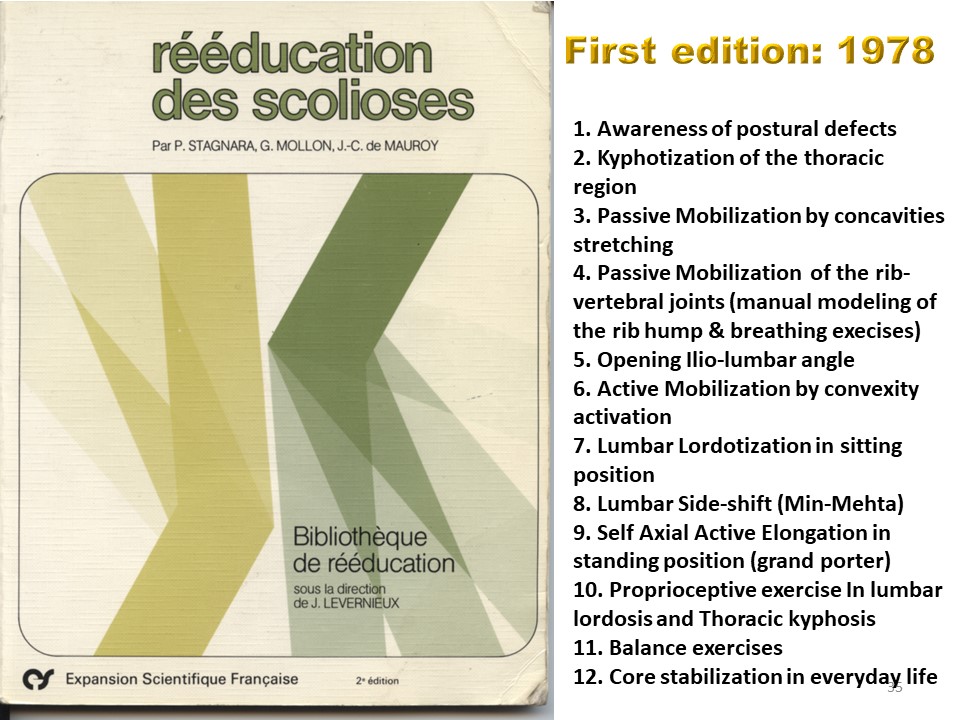 |
The 12 basic exercises of the Lyon method were published in 1978.
|
 |
These 12 exercises based on physiology will be described more precisely in section 3 with many examples. In fact the objective of this training is not an imitation, but rather the understanding of physiology to adapt to each patient.
|
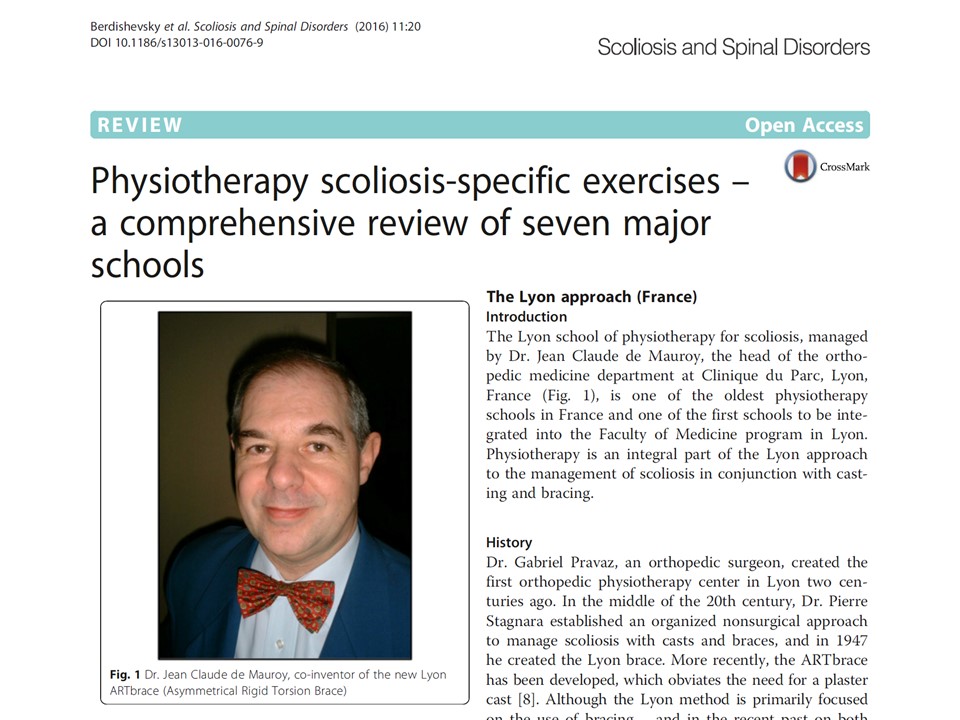 |
The seven main schools of Physiotherapy Scoliosis Specific exercises have been studied by Hagit Berdishevsky with the particularities of each.
|
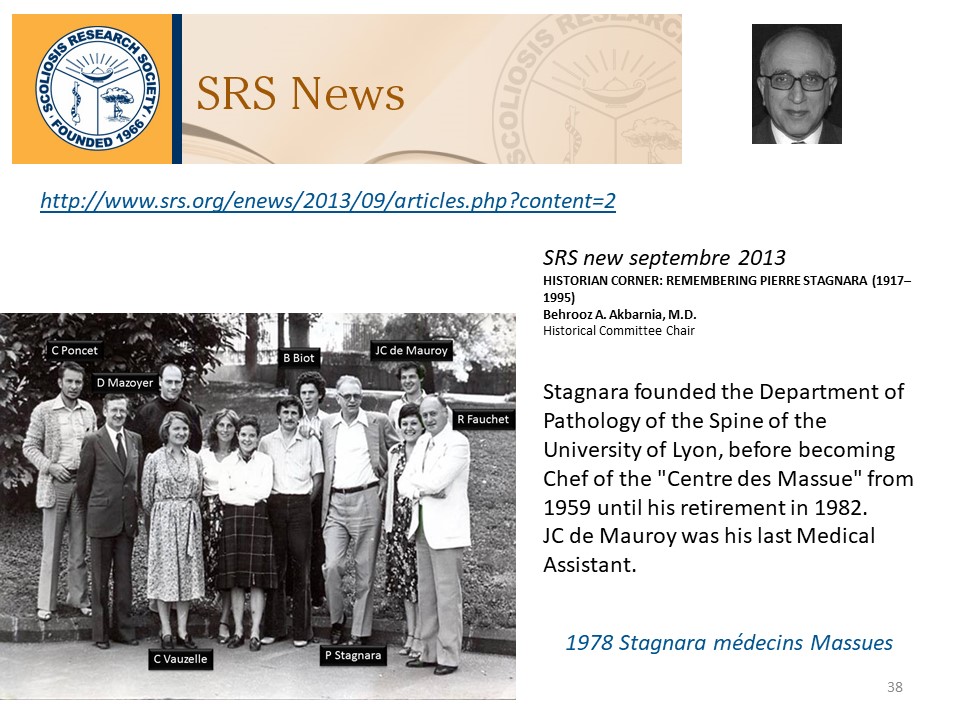 |
In this picture of the Center des Massues in 1978, Pierre Stagnara is surrounded by all his assistants.
|
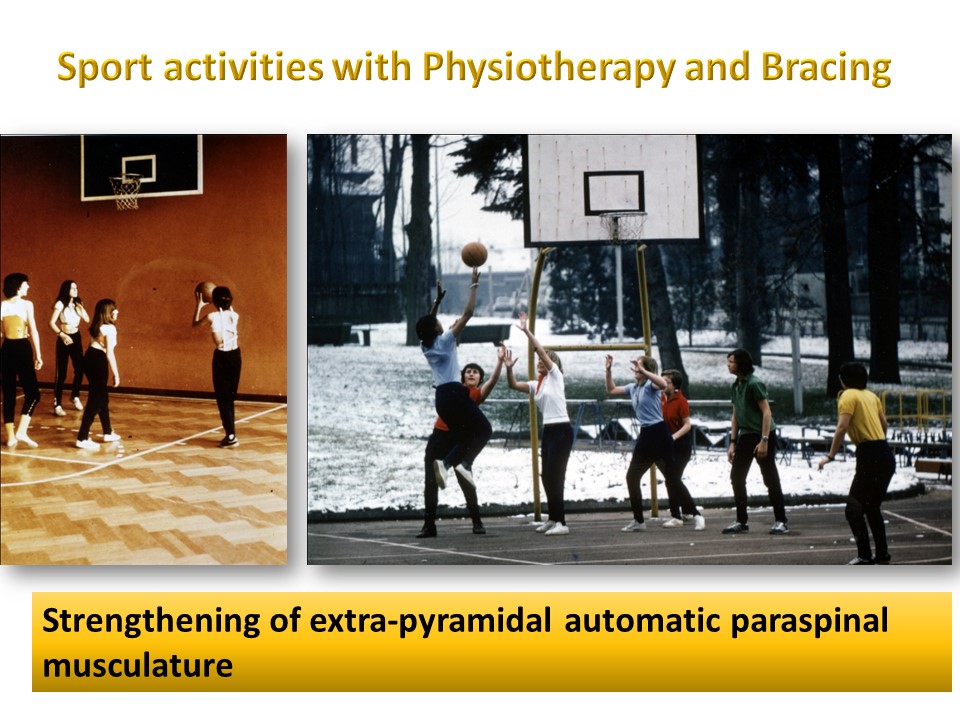 |
ADating from the same period, we see children in braces practicing sports, as in the time of Pravaz.
|
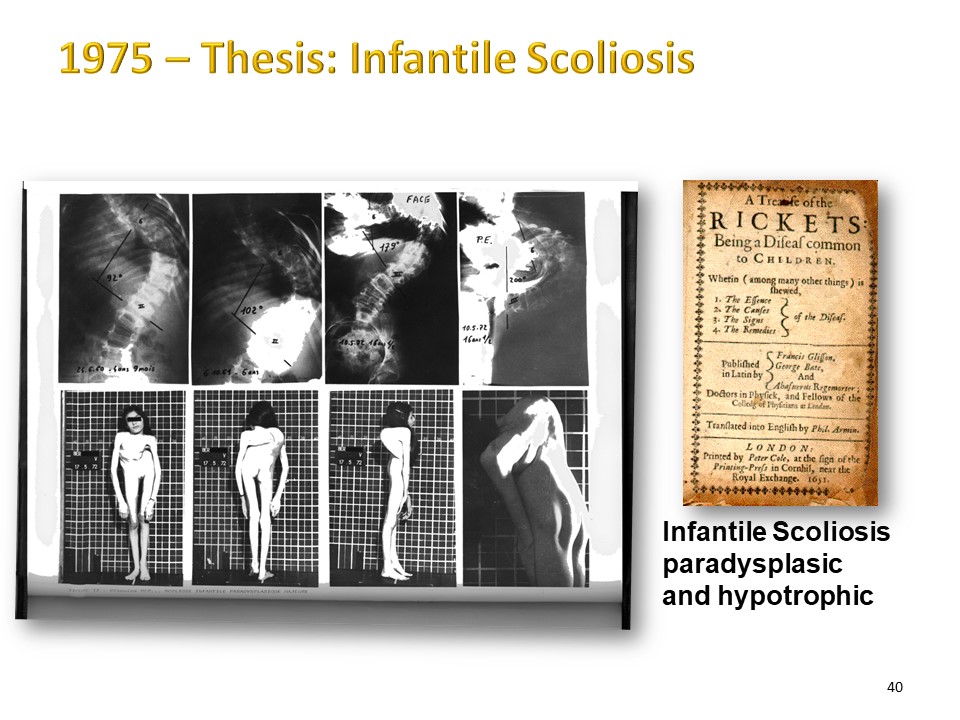 |
In 1975, Jean Claude de Mauroy defended his thesis on more than 100 infantile scoliosis. At that time, some curvatures were extremely progressive and surgical techniques did not yet allow effective stabilization.
|
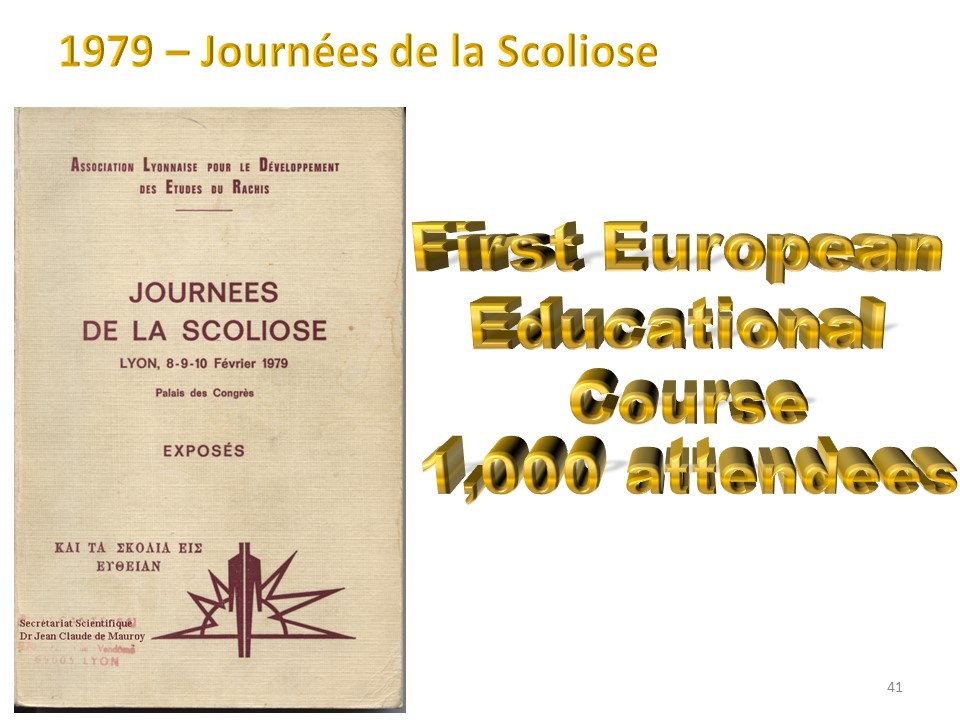 |
A first basic training "The days of scoliosis" was carried out in Lyon in 1979. 300 participants were expected, but more than 1000 registrants from all over Europe were present, showing the interest in the treatment of vertebral deviations.
|
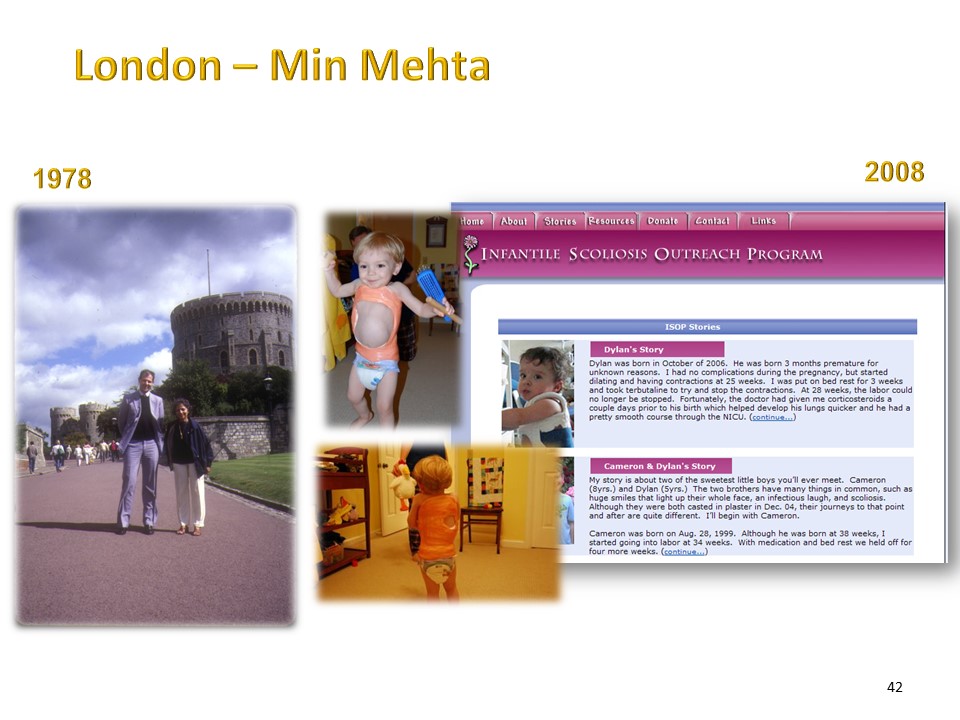 |
In addition to functional electrical stimulation tests, conventional treatments are becoming more relevant. In London, Min Mehta performs the serial casting for infantile scoliosis.
|
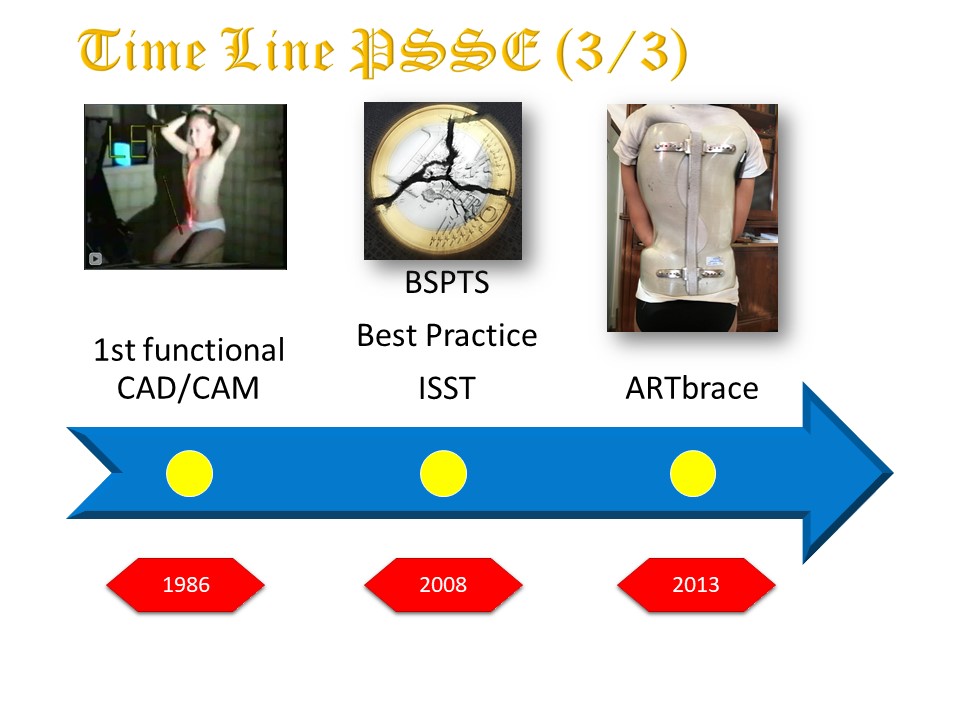 |
The following decade will see the appearance of CAD-CAM technology which has been used in Lyon since 1986. More recently, the Schroth method specializes in 3 schools. The first moldings in the corrected position appear with the ARTbrace.
|
|
In 1985, Remi Kohler (surgeon), Jean Claude de Mauroy (physiatrist), Jean Riondet (demographer) and Pierre Lecante (CPO) decided to adapt the new technologies to the production of trunk braces. They are aware of the limits of plaster casr and have a futuristic vision of the future. This working document is exceptional and summarizes the technology of the time with the 3D sensor based on a laser, an optical system and its calibration difficulties, the digitizer of the internal shape of the plaster allows you to compare the accuracy of measurements. The 3-axis milling machine for making the positive. This research will lead to Orten's first 4-column sensor which will be used for more than 20 years and which is still working today. The experience gained has allowed the current realization of ARTbrace.
|
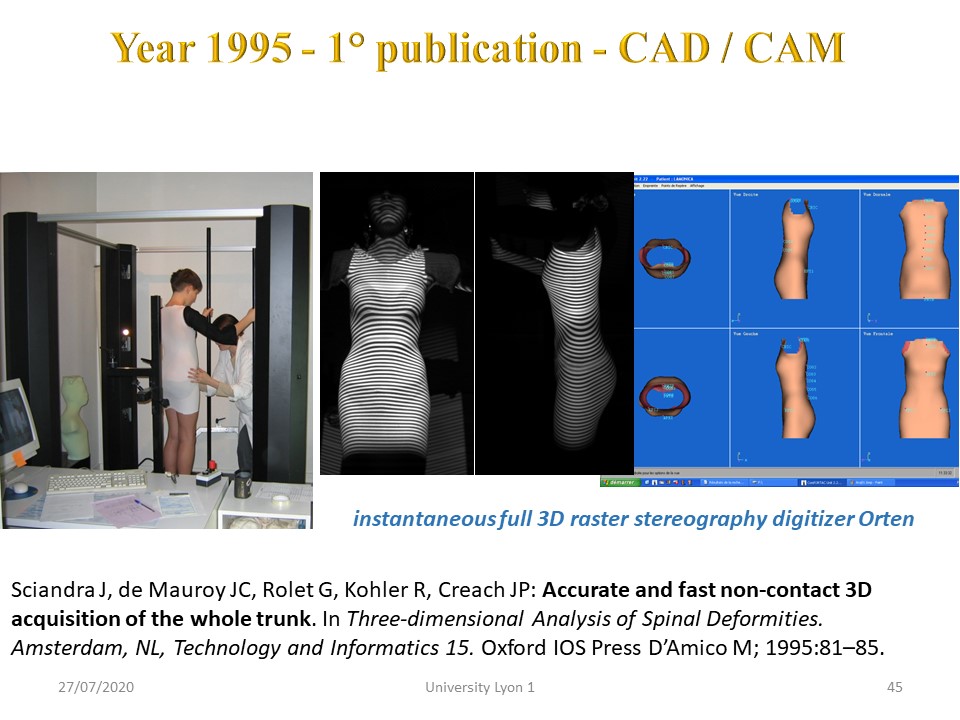 |
Our experience with instantaneous CAD-CAM started 30 years ago and for more than 20 years we have been using the first generation ORTEN system with raster stereography. This acquisition followed that of the plastered cast, but allowed much more precise molding with breathing control.
|
| |
The measurement time is a few seconds. It is thanks to the precision of the measurement and the instantaneous nature of the volume measurement that the moldings can be carried out in very precise corrective postures region by region.
|
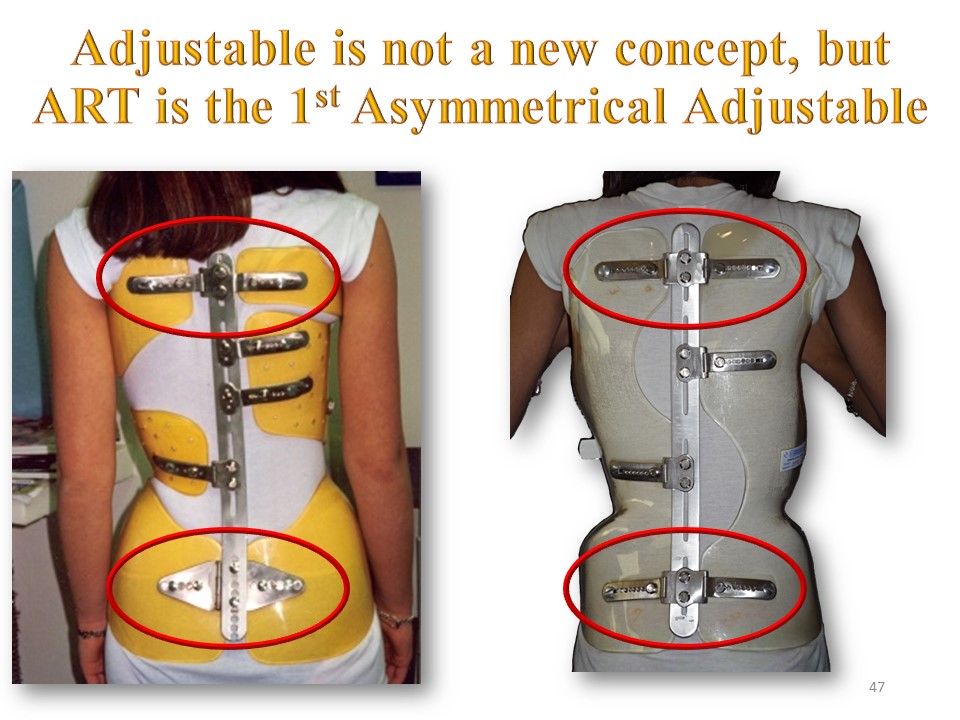 |
The new Lyon brace derives from previous braces. It combines high rigidity and asymmetry like Chêneau brace.
|
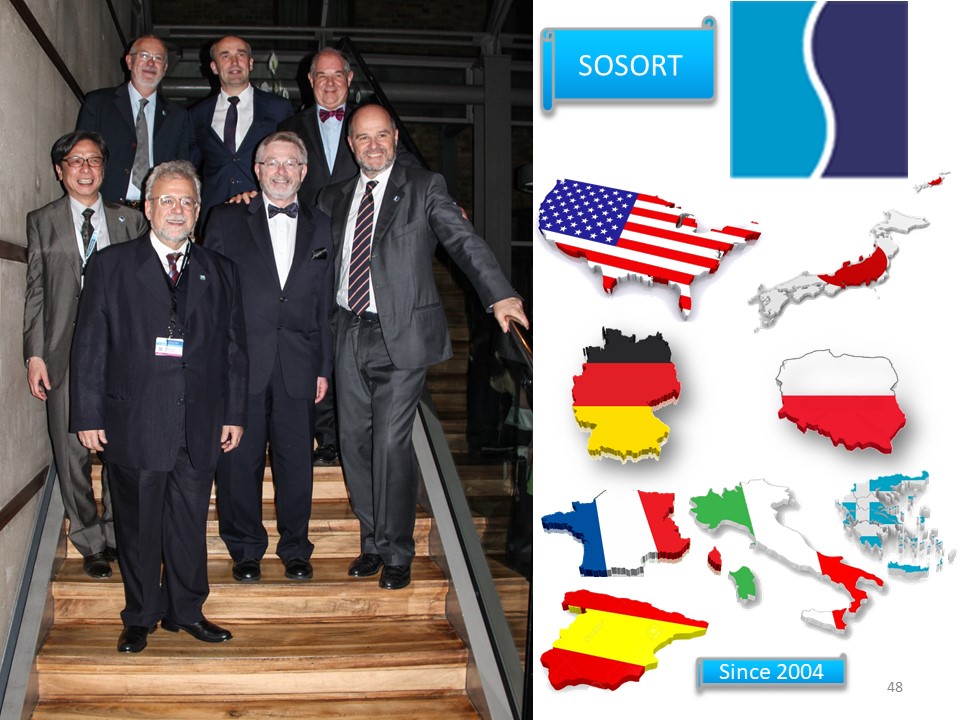 |
From 2004, the international members of SOSORT will meet once a year and draw up consensus and guidelines intended to promote the non-surgical treatment of scoliosis.
|
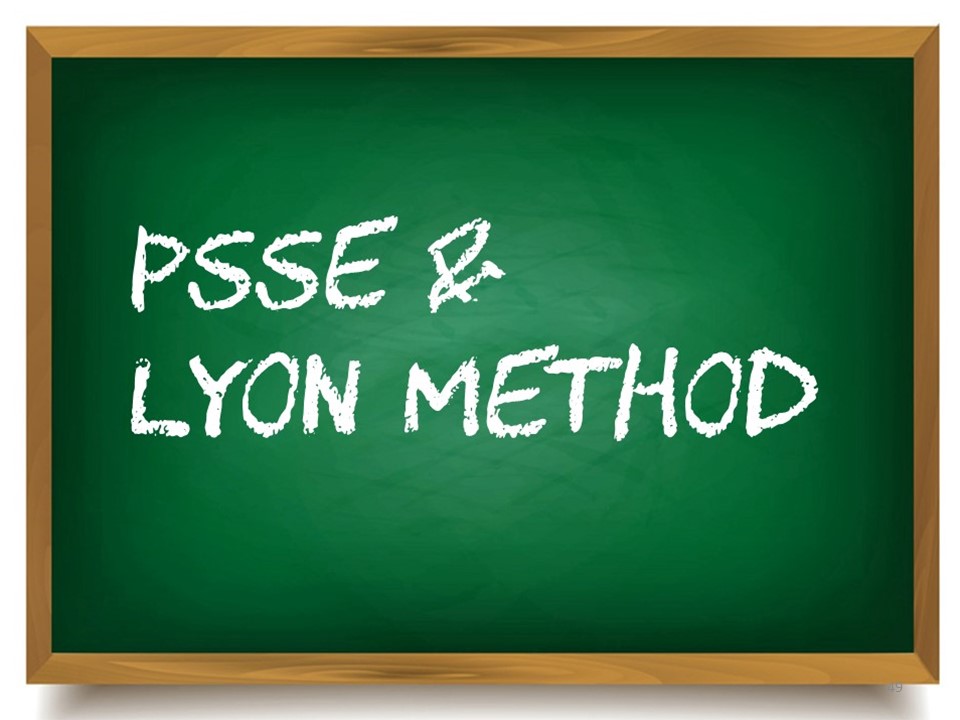 |
|
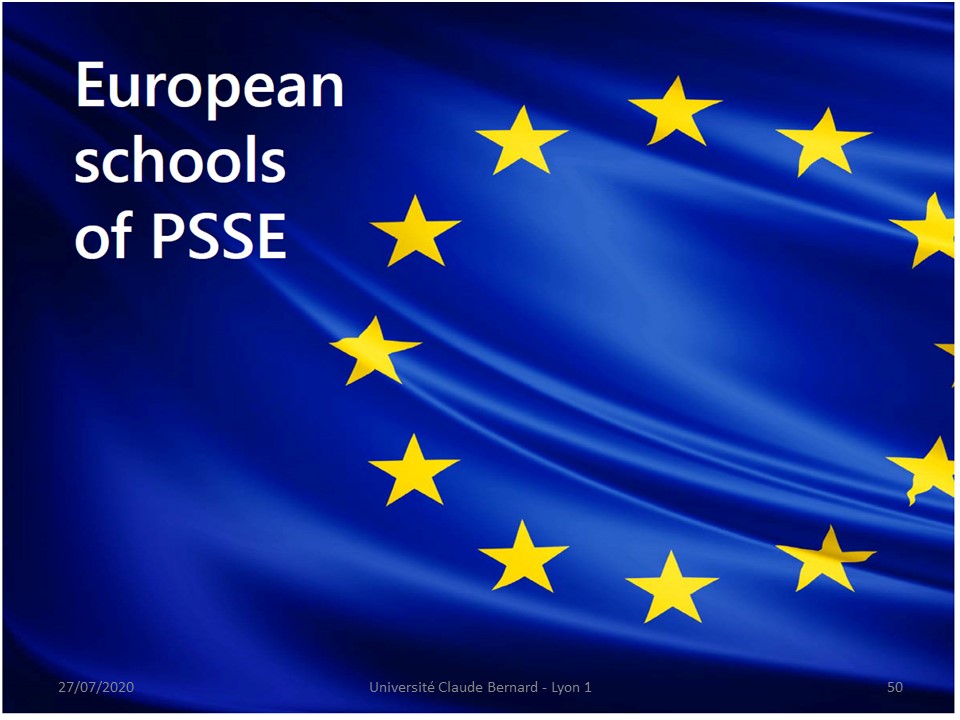 |
The methods specific to scoliosis are essentially European.
|
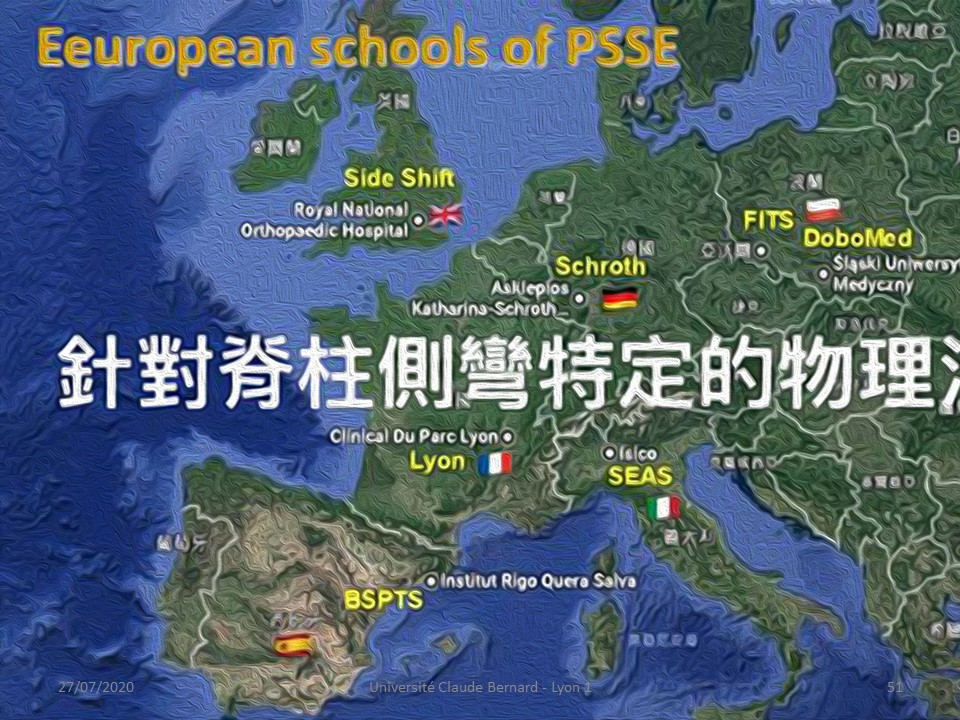 |
We will mainly study the Lyon method. Central to all other methods used in Europe.
|
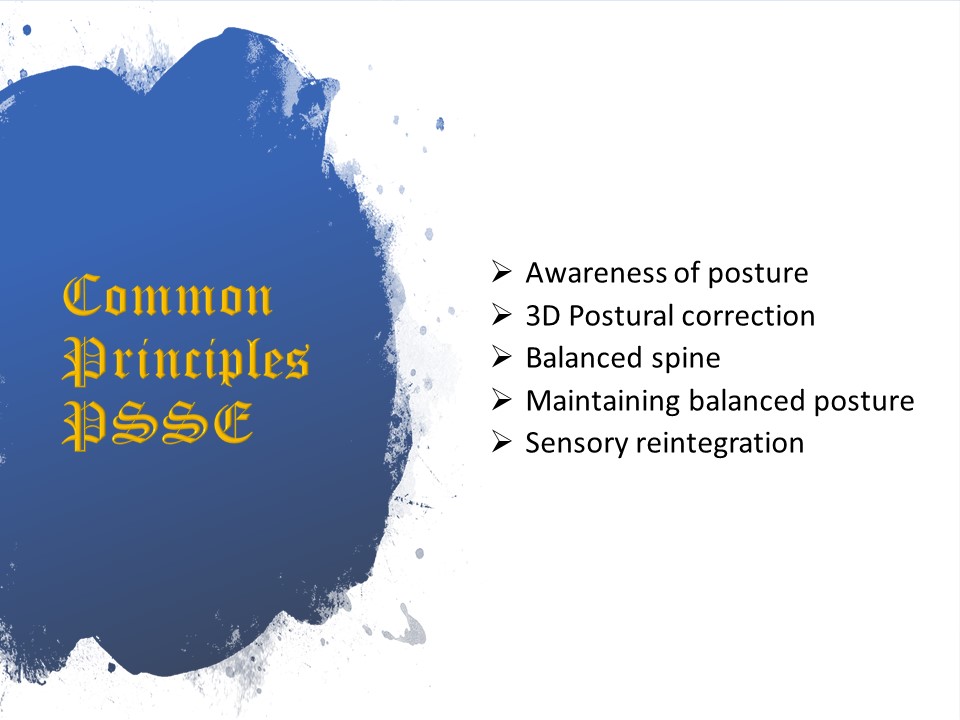 |
Many principles are common to all methods: Awareness of posture, 3D Postural correction, Balanced spine, Maintaining balanced posture, Sensory reintegration.
|
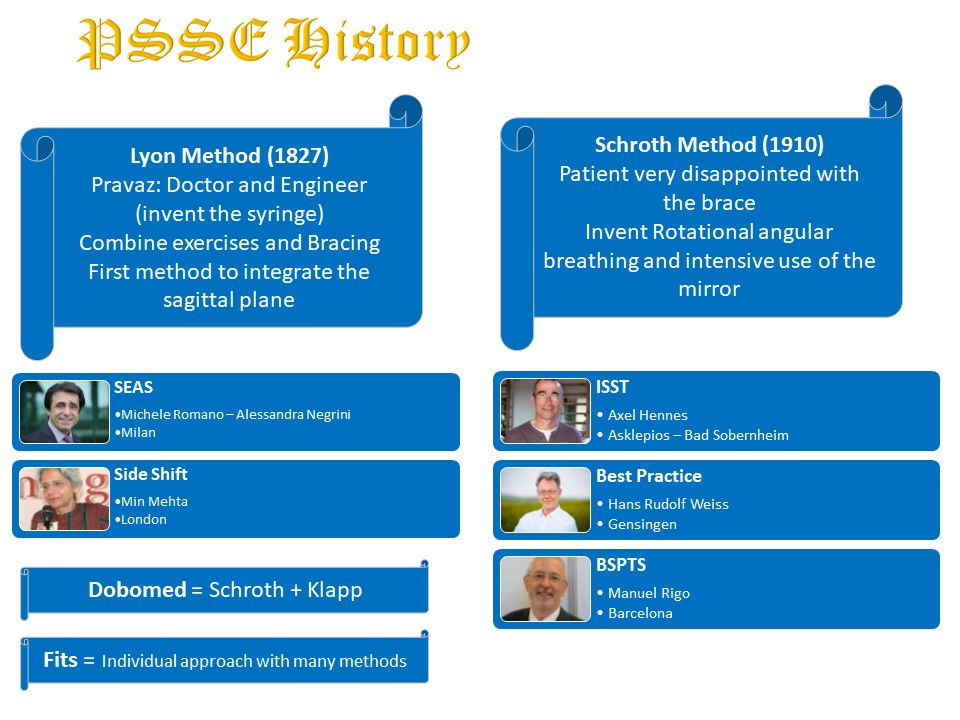 |
The methods can be grouped. 3 methods use high rigidity: Lyon, SEAS and Shift. The Schroth is associated with polyethylene braces. The two Polish methods combine other methods.
|
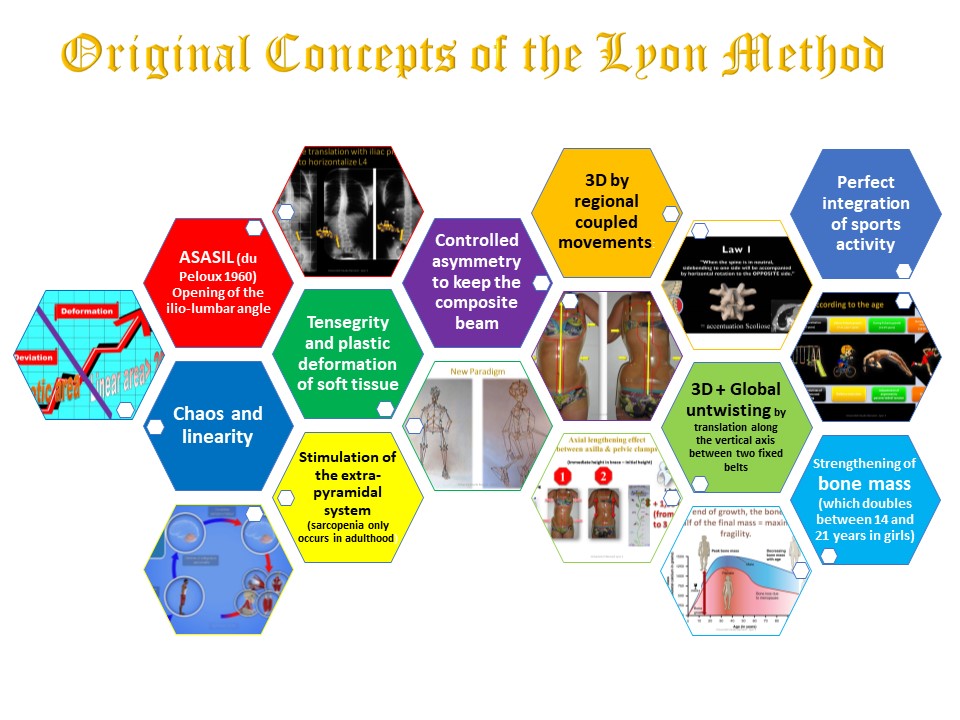 |
The lyon method is distinguished by many original concepts: chaotic and linear scoliosis, opening of the ilio-lumbar angle, Tensegrity and plastic deformation of soft tissues, Work on the extra-pyramidal automatic system, 3D correction by regional coupled movements, Isostatic balance in the sagittal plane, integration of sports activities, integration of the hypercorrective brace with physiotherapy.
|
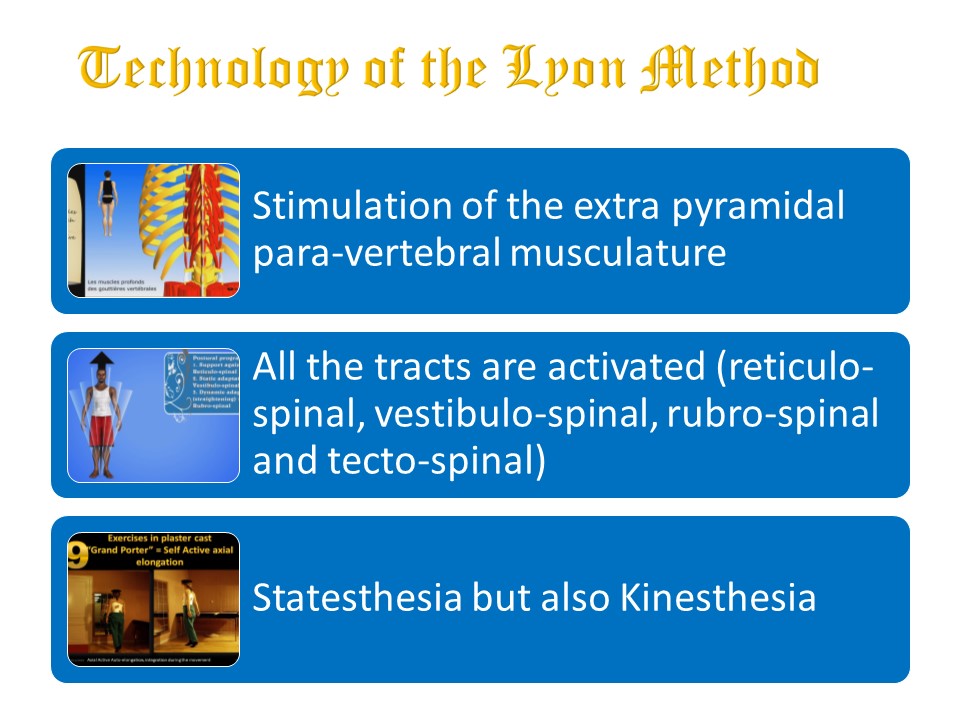  |
The stimulation of the extra-pyramidal deep paravertebral musculature is based on physiology with activation of the 4 tracts: reticulo-spinal, vestibulo-spinal, rubro-spinal and tecto-spinal. The static and dynamic sensors will be stimulated.
|
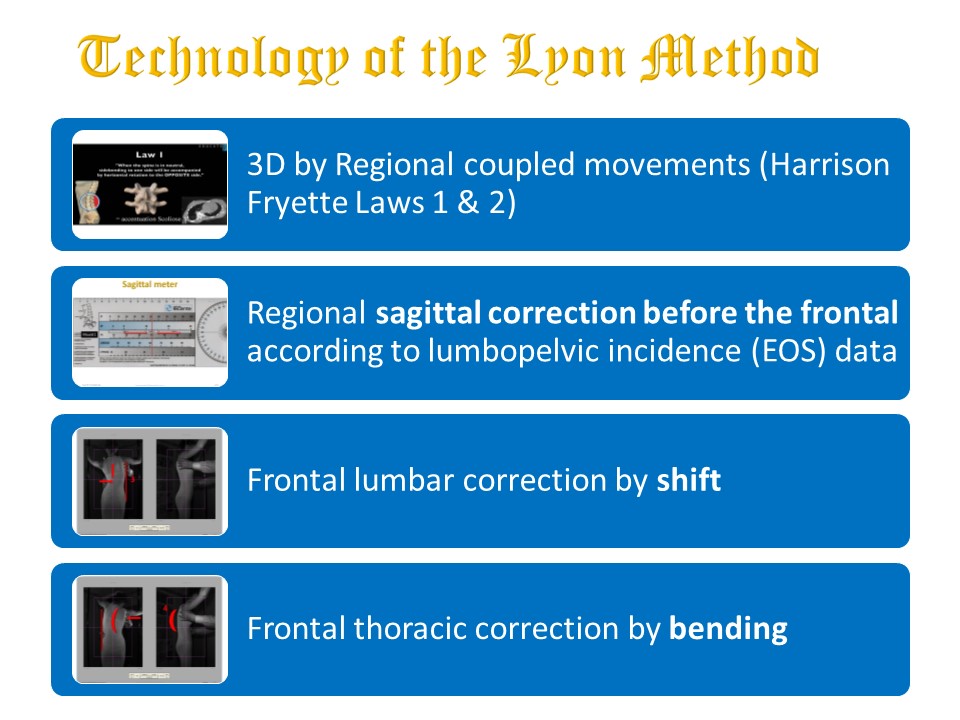 |
3D correction by coupled movements is performed in the sagittal plane and in the frontal plane. In the sagittal plane, the isostatic balance is defined by the sagittalometer according to the lumbo-pelvic incidence for the pelvic version, lordosis and kyphosis. In the frontal plane, the correction takes into account the orientation of the posterior facet-joints: bending by rotation around the sagittal axis for the thoracic region and shift by translation along the transverse axis for the lumbar region.
|
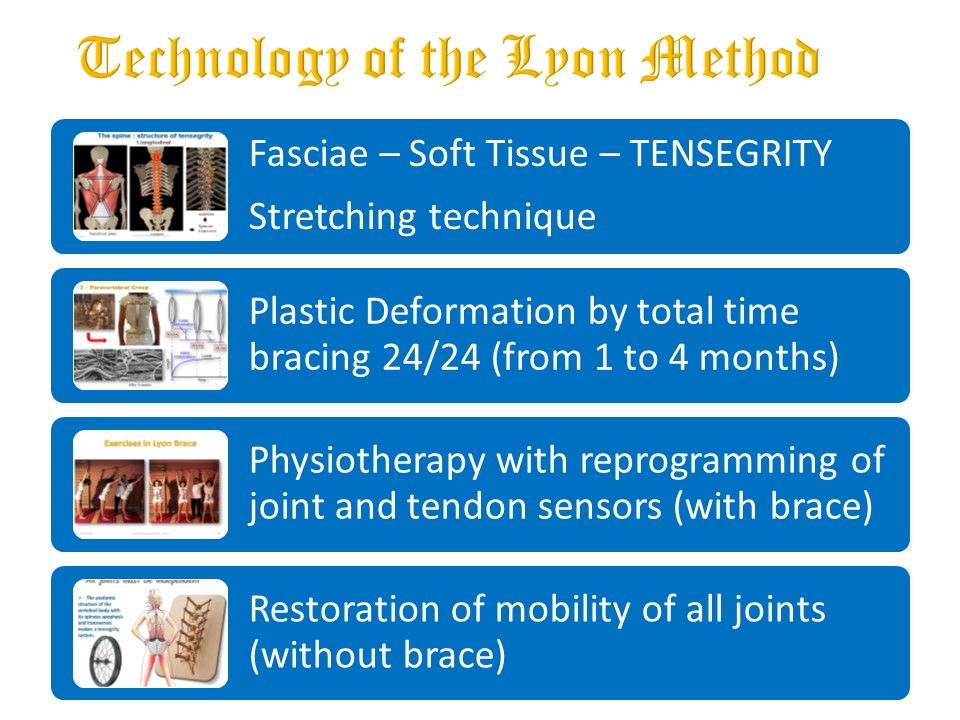 |
The Lyon Method is the opposite of fitness, the problem is not muscle weakness (sarcopenia only affects adults), but an asymmetry of tension in the fascia. This is why stretching techniques and plastic deformation during "total time" are preferred. In a context of tensegrity, it is also important to maintain the mobility of all the vertebral segments.
|
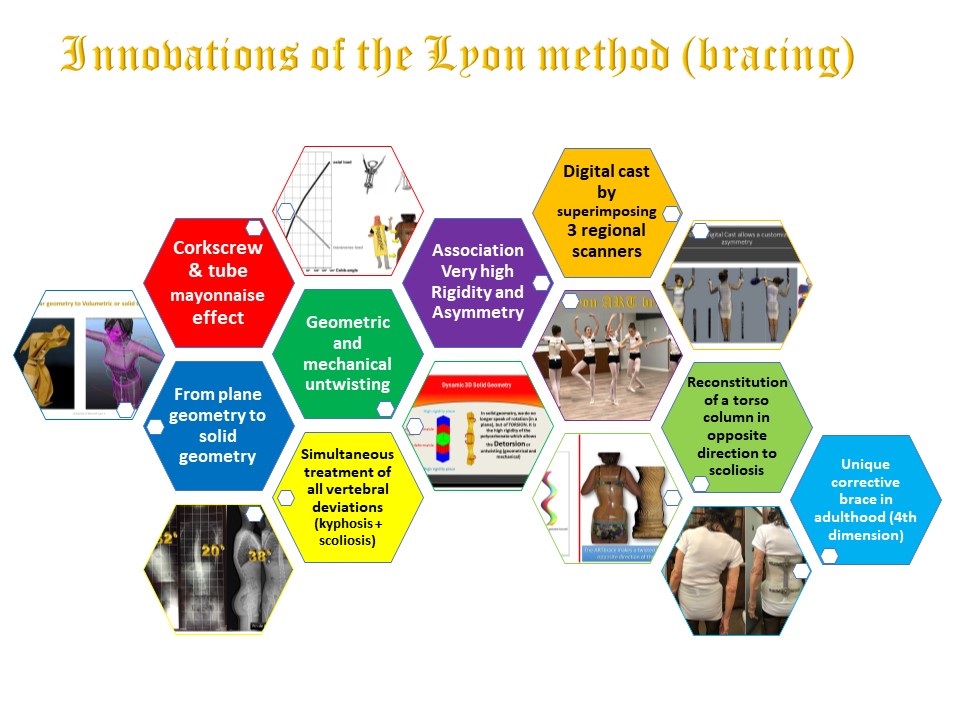 |
With regard to the new Lyon ARTbrace, there are many innovations: "pull" by corkscrew effect, solid geometry, overall detorsion, Correction of the sagittal plane in isostatic balance, association of controlled asymmetry and very high rigidity, regional molding in corrected posture, 3D by coupled movements (frontal correction in sagittal isostatic balance), corrective brace in adults...
|
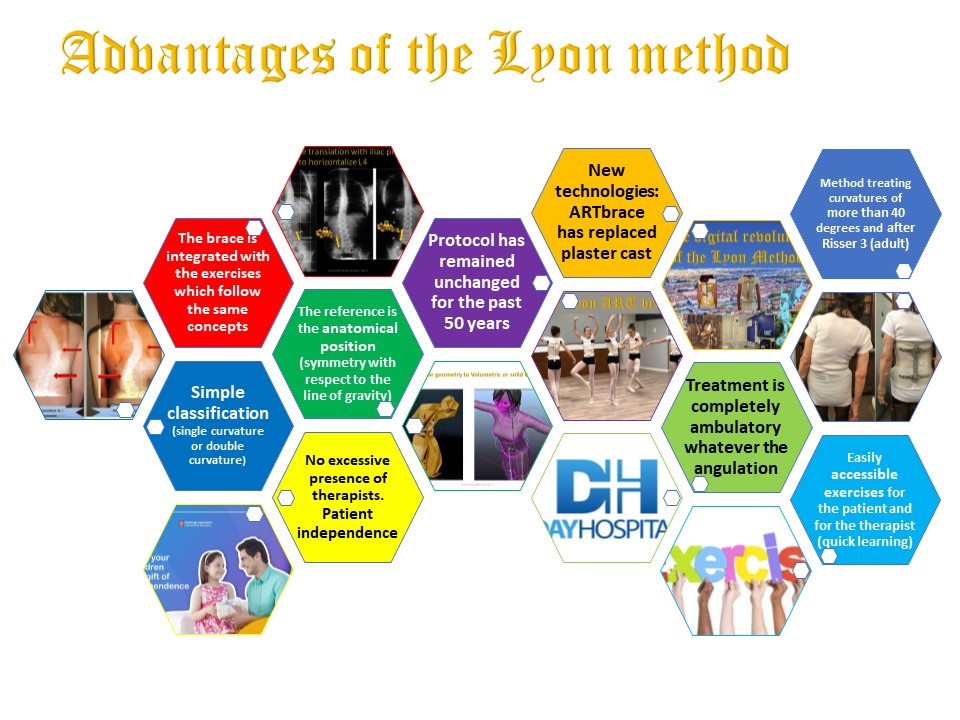 |
The advantages of this new technology are multiple: brace and exercises are integrated and follow the same concepts, the classification is simple (one or two curvatures), the sagittal plane is in isostatic balance personalized according to the lumbopelvic incidence, the protocols have been identical for 50 years even if new technologies have made it possible to replace the plaster cast with "total time", the treatment is completely ambulatory, hypercorrection allows the treatment of soft tissues for scoliosis after Risser 3 and some curvatures of more than 40 °, the treatment is completely ambulatory whatever the angulation ...
|
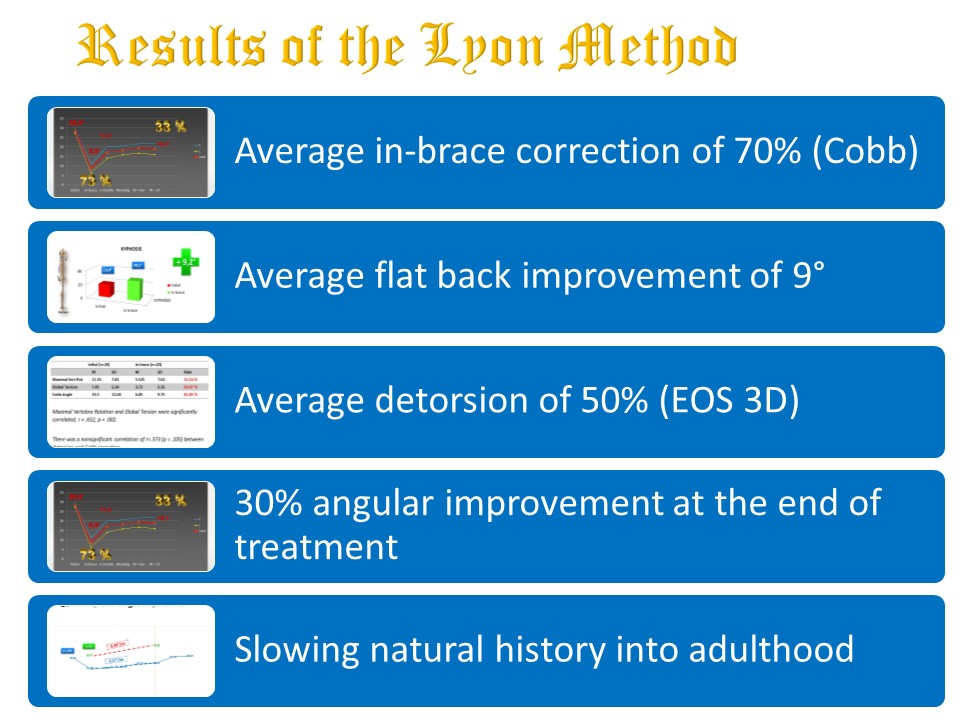 |
The results of treatment with Lyon ARTbrace are exceptional:
average in-brace correction in the frontal plane greater than 70%,
average improvement of the flat back by 9 °
significant detorsion of up to 50%
definitive average correction at the end of treatment of 30%
slowing down the natural history of scoliosis in adulthood.
|
 |
|
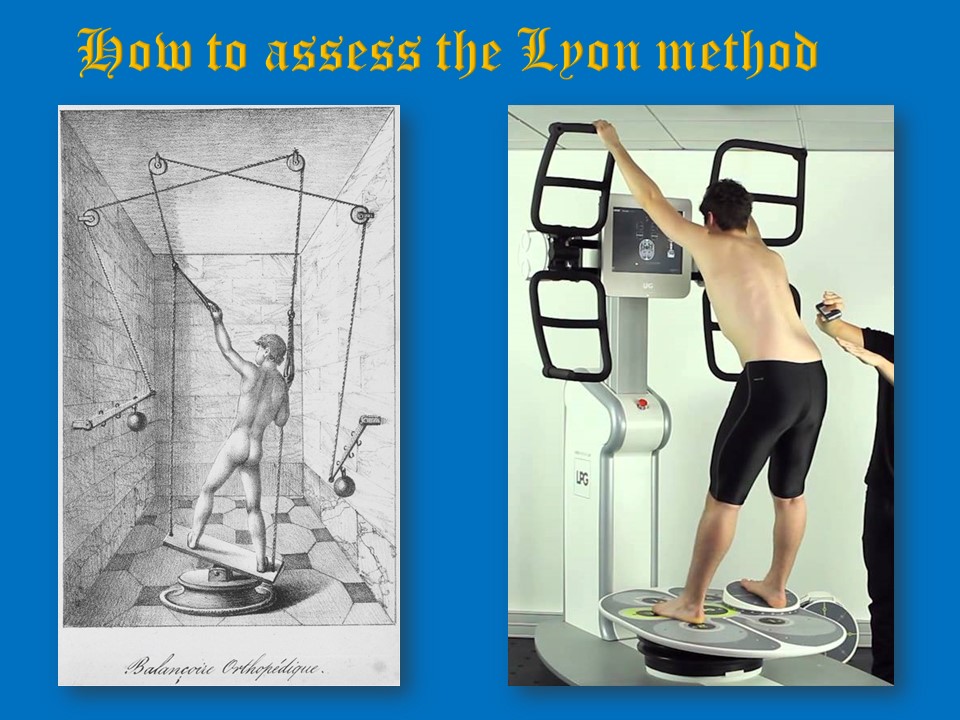 |
One of the major criticisms of scoliosis physiotherapy is the impossibility of objectively evaluating the results. It is not the same for the Lyon method. Advances in technology have made it possible to motorize the platform and especially to assess the improvement of the extra-pyramidal system.
|
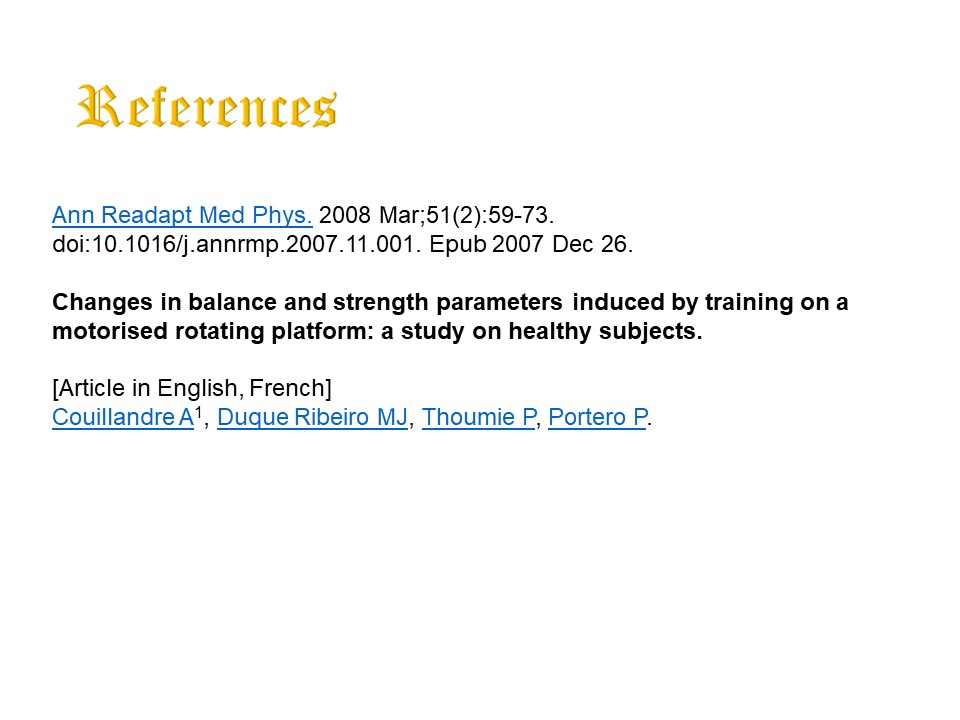 |
Let's take the example of the computerized Uber system, which not only allows us to evaluate the extrapyramidal system, but is also an instrument of physiotherapy to treat its deficiencies.
|
 |
An integrated functional evaluation adapted to all types of patients for an accurate assessment of their health status and better monitoring of their rehabilitation. Consisting of 7 reference tests: stability test. 50-second test with eyes open and closed in bipodal support.
|
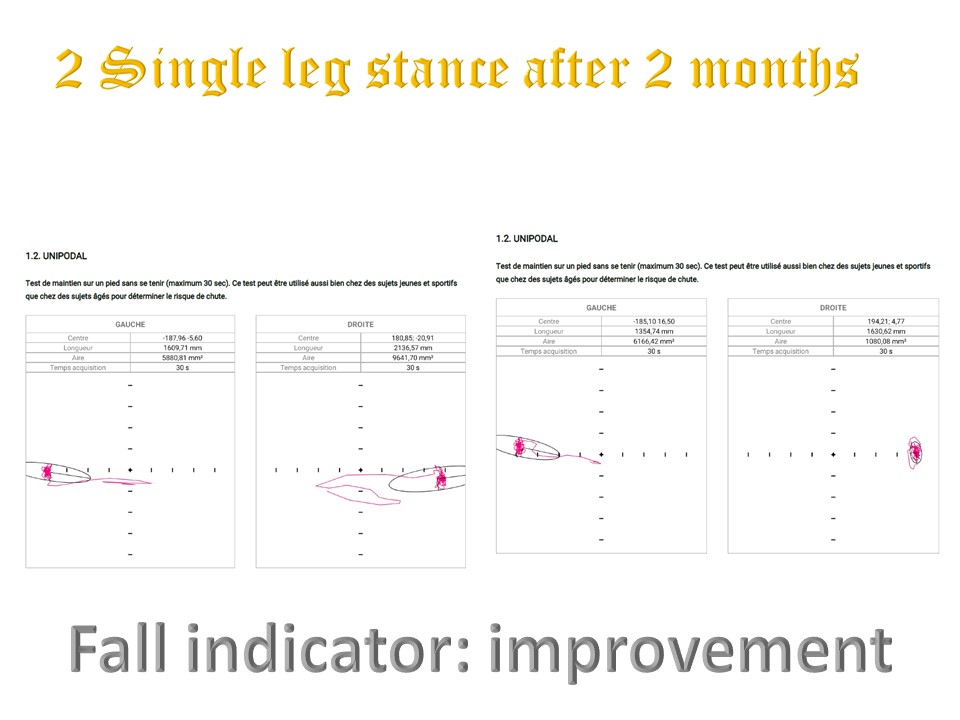 |
Fall indicator in unipodal position: 30-second hold test on one foot.
|
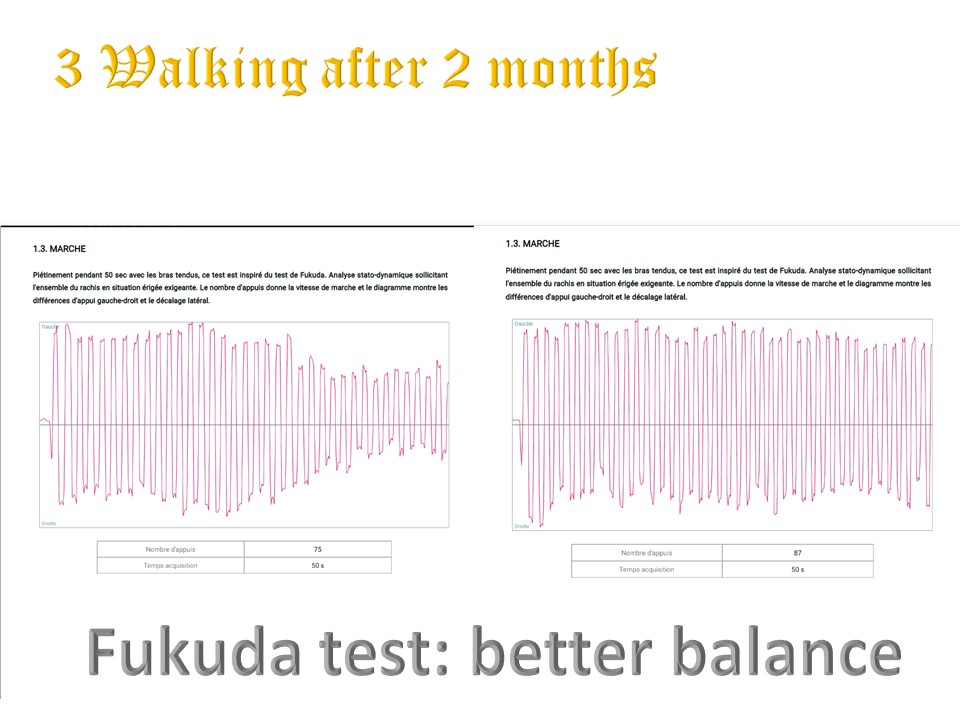 |
The Fukuda test: A 50-second walk on the spot: Trampling for 50 seconds with arms outstretched.
|
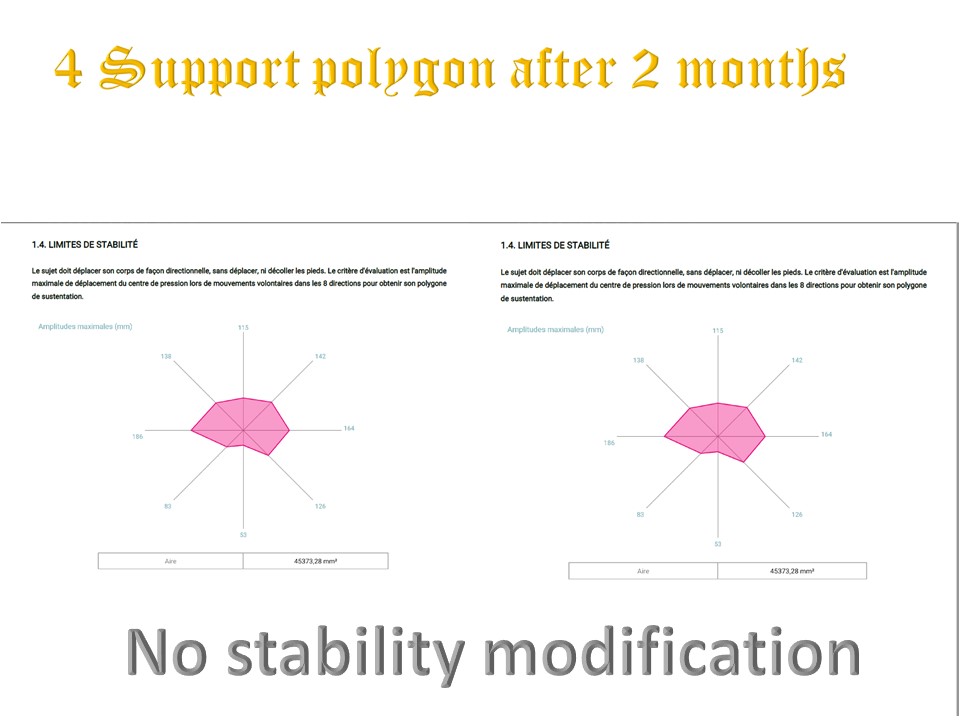 |
Stability limits. The subject must move the body in a directional manner, without moving or removing the feet.
|
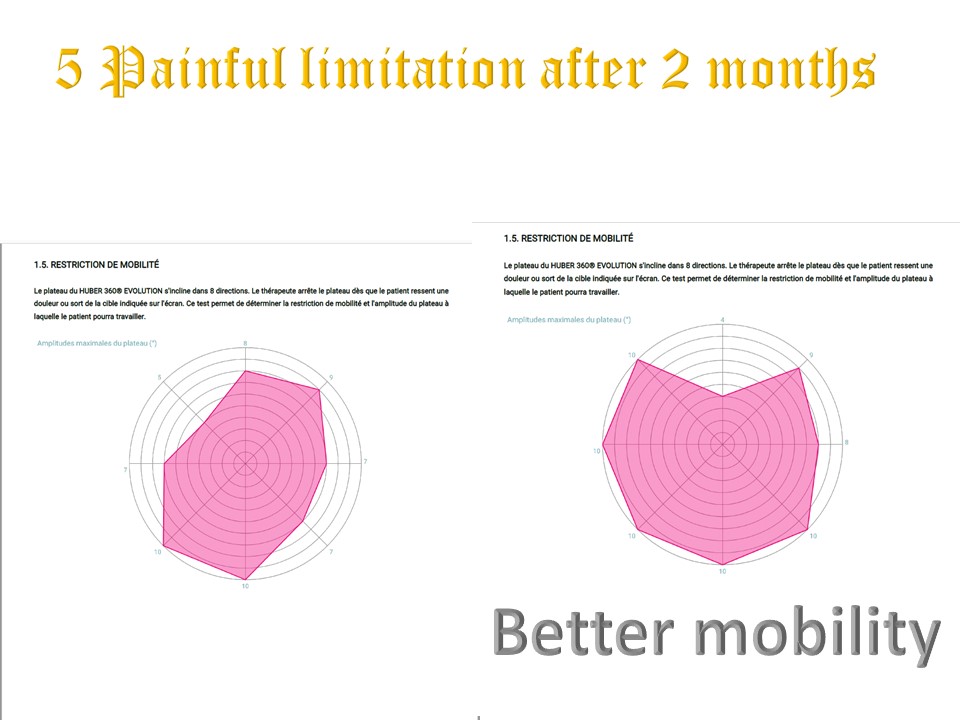 |
Restriction of mobility with pain. The plate tilts in 8 directions. The therapist stops the plate as soon as the patient feels pain or the patient moves away from the target indicated on the screen.
|
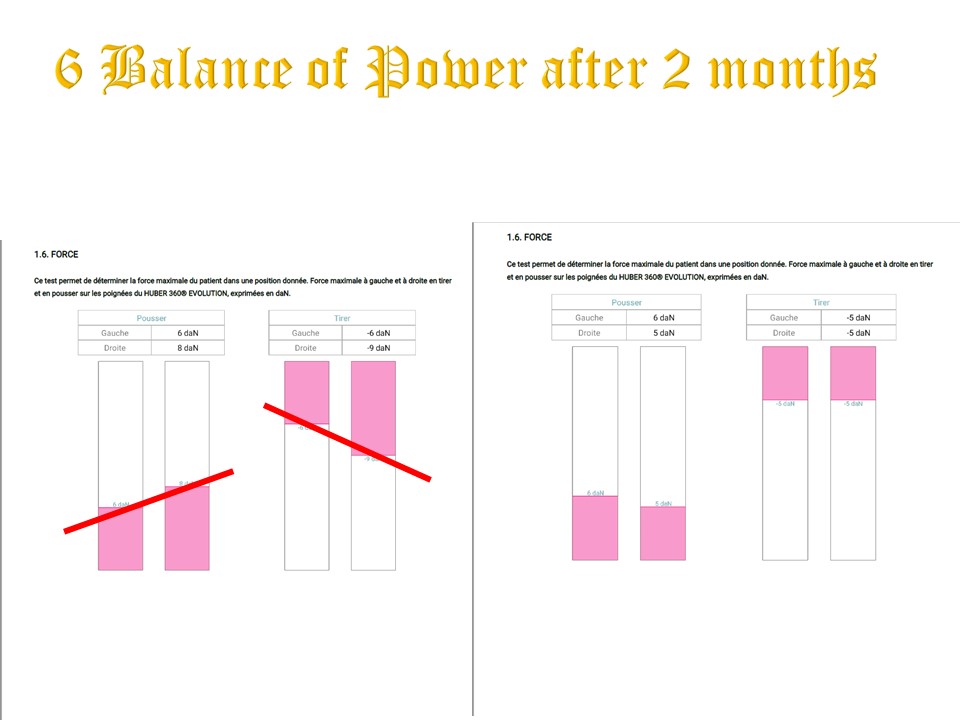 |
Force Balance: This test is used to determine the maximum force of the patient in a given position. Here the maximum force to the right and left when pulling and pushing. You can see the balance of right and left force.
|
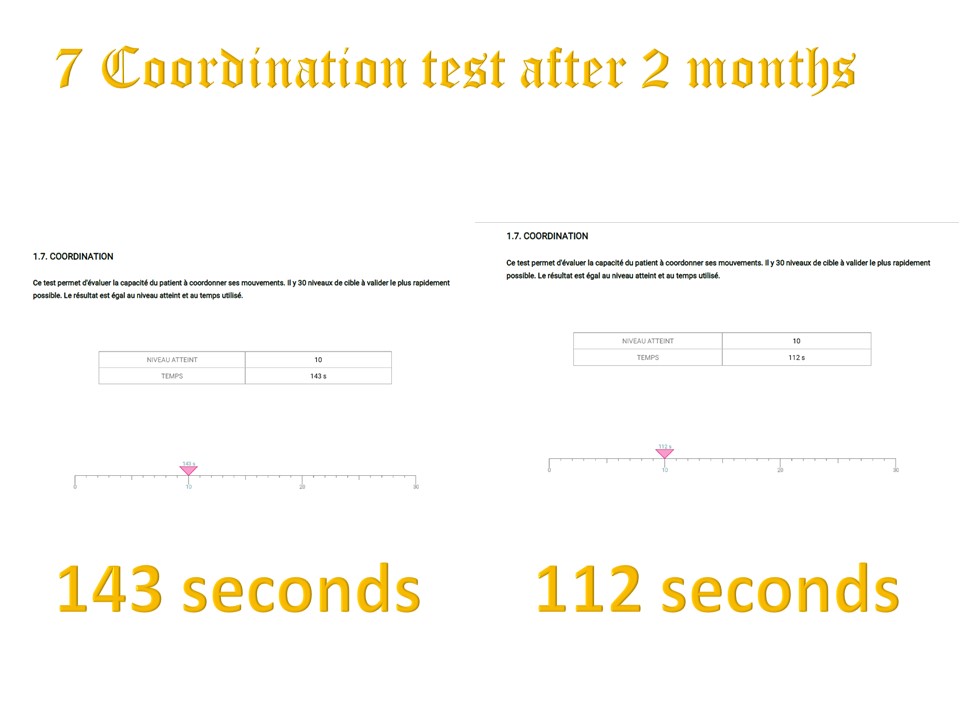 |
Coordination test. 30 target levels to be validated as soon as possible. Time is calculated according to the level reached.
In conclusion, the Lyonese method based on extrapyramidal system stimulation has developed over the last 200 years. Results can be evaluated objectively.
|
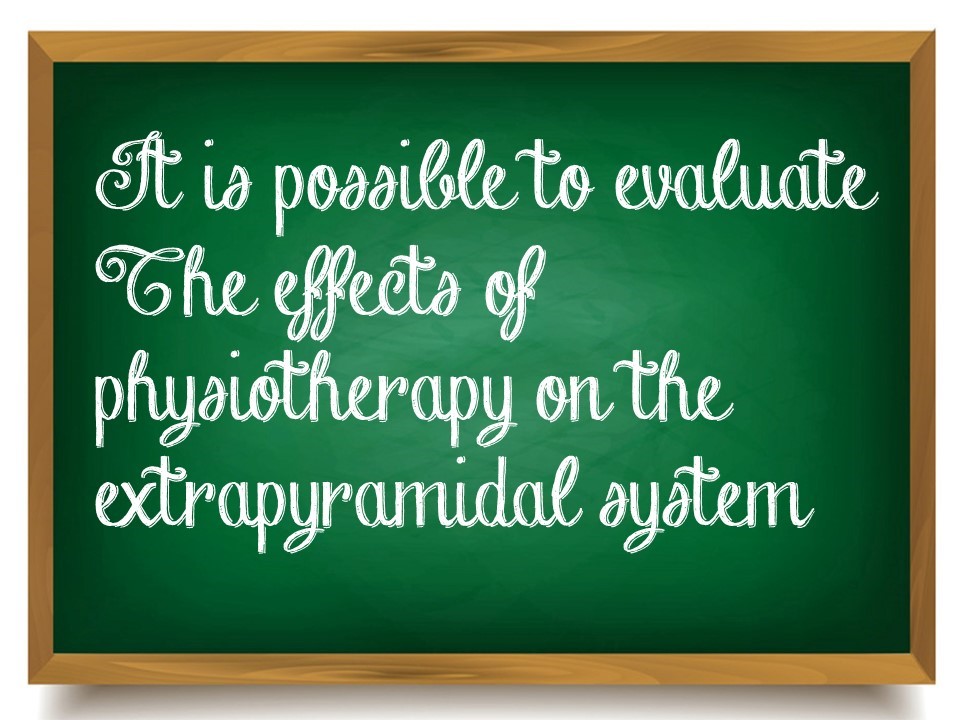 |

To register for Certification, please contact SSOL
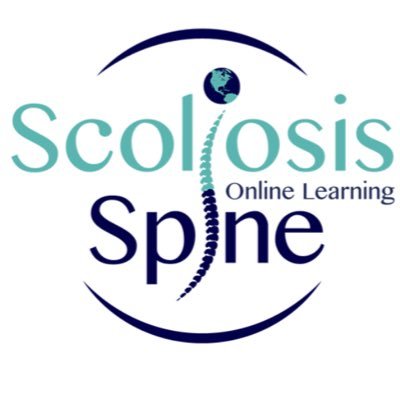
|